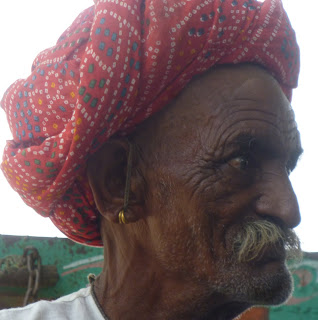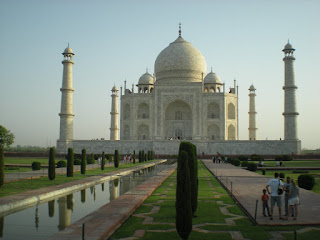Warming dew dampened my bare feet as I trotted through the tall grass that blanketed the berm dividing the two cultivated plots to either side. The sun snuck through the tall trees to my east and though its newborn rays barely reached my feet at that point, I felt its emanating warmth tickle my toes. More berms jutted out from either side of the central path I walked upon, dissecting the two larger plots into ten or so smaller plots. During harvest season these small plots grow hundreds of different varieties of seed, to name a few: lentils, eggplants, thyme, rosemary, mint, lemon balm, okra, coriander, chilies, ginger, turnips, mustard, barley, millet, any number of their 500 paddy strains and 80 races of wheat. A collection that makes Navdanya’s farm a true crown jewel of biodiversity, and not just in India.
Navdanya didn’t always boast such diversity, once a barren monoculture, it took five dedicated years to transform the lush, loamy soil. Starting in 1987 as a movement for seed conservation and empowering and protecting the local farmers of India, Navdanya’s influence has grown with it’s soil and seed over the years: slowly enlightening its entire community to the wealth of organics.
The seeds sewn here almost make it through their entire sequence of life: they are planted, given time, sun and water enough for them to germinate, sprout, bare fruit, flower, and just before their seeds fall back into the earth to become the children of next years harvest, they are collected and stored in Navdanya’s Seedbank.
Meandering along the berm path through bigger fields, more smaller seed plots and forest gardens, I eventually came across the seedbank. A group of workers washed mason jars outside and smiled as I entered the building through a door on the left. The small structure was made of the earth: mud, clay and cow dung shaped the walls, with straw used as the fiber to give it congealing strength (like rebar in cement buildings). The thick, earthen walls kept it cool, like an above ground root cellar, and a northern facing window cast light, but not heat into the room. Hundreds of jars filled glass-paned cabinets throughout the room, and flowered grains and chili plants hung from a string on the ceiling as they dried and waited for their seed to be extracted and stored. The cabinets had labels delineating their contents: medicinal plants, ornamental timbers, spices, oil-bearing seeds (like mustard), vegetables, legumes, cereals and millets. The room adjacent to this one had larger vats containing greater quantities of seed. These seeds were given free of charge to farmers hoping to start organic farms, or already practicing and lacking the money for seed. The farmers then grow the plants, harvest the produce, and collect the seed. For each kg of seed borrowed from Navdanya, they must return 1 and a ¼ kg to keep the seed variety alive, and so future farmers can enjoy the fruits of seed sovereignty.
Outside the seedbank my nose followed the distinct scent of cows that led me past the stables, earthen-made as well. The distinct sounds of cow’s off-center chews distracted me as I watched their tails lazily wag flies off their backs. Soon, I noticed a big blue container standing outside. After curiously poking inside and observing the strong scented, yellow liquid within, I stopped and pondered.
“It is what you think it is,” a worker told me as he noticed my query. “It’s cow urine.”
I’d heard of cow urine’s incredible uses for pesticide and plant nutrition, and some farmers had began replacing their synthetic fertilizers with this otherwise wasted byproduct…But Navdanya added a new property to its list of alleviations: a health elixir….for humans.
“1 Tsp. each morning does wonders on human health…I take it myself.” The man told me.
After pondering the taste of cow-urine, I moved my mind onwards to another barn just past the stables. Long, skinny, brick-laid rectangle spanned the barn, only about six inches high, but they guarded thick plots of soil. Reaching a hand and turning the soil could reveal hundreds of skinny, red wrigglers with each handful. The worms ate and digested the soil, turning it into potent, organic fertilizer after only a few weeks. Small amounts of this could be spread over entire acres, saving time, money, and a debt-ridden dependence on commercial fertilizers.
Outside the vermiculture barn stood a large clay container that looked like a tall, skinny barrel. The container was usually piled up with 6 inches of small rocks, 6 inches of pebbles, 6 inches of sand, 6 inches of manure, a thin layer of worms, and some loose hay on top. Above the open-top barrel hung a small bucket with tiny holes punched into its underside that allowed for water to slowly drip into the layers below. After gradually filtering through the system water was collected from the spout below and spread over the crops to suppress diseases, and provide nutrients for plant growth. This “compost tea” is a safe, affective and cheap alternative to synthetic varieties.
I started back towards the path along the grassy berm. I gazed as a slew of radiant butterflies danced in the morning sun, I could hear the hum of honeybees out on morning patrol, buzzing, chirping, and insect gossip all began to fill the air around me; I paused for a moment and allowed my senses time to catch up, and I realized, this place is truly a haven for life of all kinds. Navdanya is a hallmark of biodiversity, seed conservation, and organic farming techniques that save time, money, and empower the farmers who use them. Navdanya’s uses for manure as fertilizer, pesticides, herbicides and heating redefine what is waste on the farm. Their efforts in seed conservation have reclaimed hundreds of India’s indigenous seed varieties. Navdanya’s efforts helped pushed their state of Uttarakhand to declare itself a Genetically Modified free state. But their sphere of influence doesn’t stop in their direct communities, but with their half a million famers in India, and their many supporters abroad; which makes Navdanya a true beacon for change in a world becoming vastly dependent on unnecessary resources.































